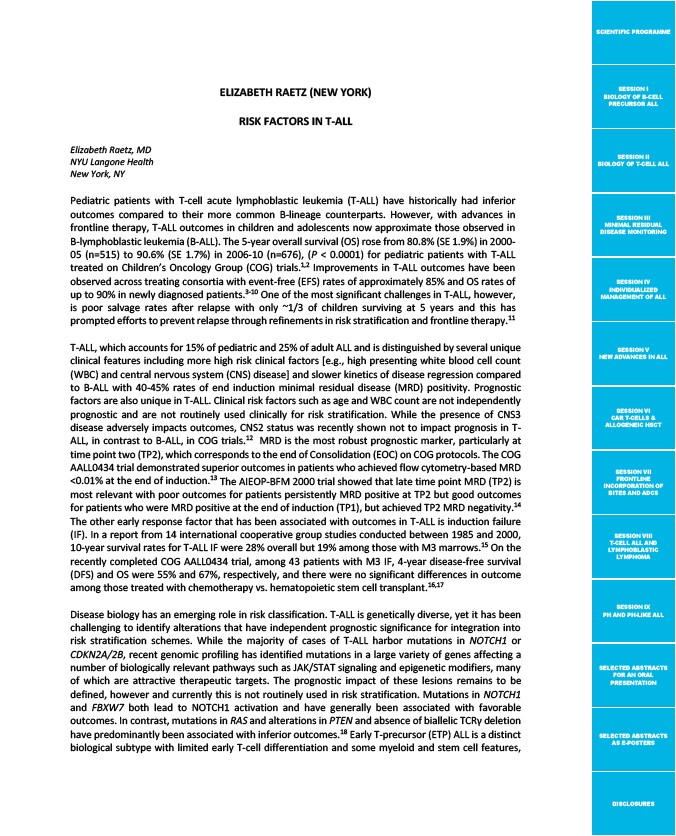
SCIENTIFIC PROGRAMME
SESSION I
BIOLOGY OF B-CELL
PRECURSOR ALL
SESSION II
BIOLOGY OF T-CELL ALL
SESSION III
MINIMAL RESIDUAL
DISEASE MONITORING
SESSION IV
INDIVIDUALIZED
MANAGEMENT OF ALL
SESSION V
NEW ADVANCES IN ALL
SESSION VI
CAR T-CELLS &
ALLOGENEIC HSCT
SESSION VII
FRONTLINE
INCORPORATION OF
BITES AND ADCS
SESSION VIII
T-CELL ALL AND
LYMPHOBLASTIC
LYMPHOMA
SESSION IX
PH AND PH-LIKE ALL
SELECTED ABSTRACTS
FOR AN ORAL
PRESENTATION
SELECTED ABSTRACTS
AS E-POSTERS
DISCLOSURES
ELIZABETH RAETZ (NEW YORK)
RISK FACTORS IN T-ALL
Elizabeth Raetz, MD
NYU Langone Health
New York, NY
Pediatric patients with T-cell acute lymphoblastic leukemia (T-ALL) have historically had inferior
outcomes compared to their more common B-lineage counterparts. However, with advances in
frontline therapy, T-ALL outcomes in children and adolescents now approximate those observed in
B-lymphoblastic leukemia (B-ALL). The 5-year overall survival (OS) rose from 80.8% (SE 1.9%) in 2000-
05 (n=515) to 90.6% (SE 1.7%) in 2006-10 (n=676), (P < 0.0001) for pediatric patients with T-ALL
treated on Children’s Oncology Group (COG) trials.1,2 Improvements in T-ALL outcomes have been
observed across treating consortia with event-free (EFS) rates of approximately 85% and OS rates of
up to 90% in newly diagnosed patients.3-10 One of the most significant challenges in T-ALL, however,
is poor salvage rates after relapse with only ~1/3 of children surviving at 5 years and this has
prompted efforts to prevent relapse through refinements in risk stratification and frontline therapy.11
T-ALL, which accounts for 15% of pediatric and 25% of adult ALL and is distinguished by several unique
clinical features including more high risk clinical factors e.g., high presenting white blood cell count
(WBC) and central nervous system (CNS) disease and slower kinetics of disease regression compared
to B-ALL with 40-45% rates of end induction minimal residual disease (MRD) positivity. Prognostic
factors are also unique in T-ALL. Clinical risk factors such as age and WBC count are not independently
prognostic and are not routinely used clinically for risk stratification. While the presence of CNS3
disease adversely impacts outcomes, CNS2 status was recently shown not to impact prognosis in T-ALL,
in contrast to B-ALL, in COG trials.12 MRD is the most robust prognostic marker, particularly at
time point two (TP2), which corresponds to the end of Consolidation (EOC) on COG protocols. The COG
AALL0434 trial demonstrated superior outcomes in patients who achieved flow cytometry-based MRD
<0.01% at the end of induction.13 The AIEOP-BFM 2000 trial showed that late time point MRD (TP2) is
most relevant with poor outcomes for patients persistently MRD positive at TP2 but good outcomes
for patients who were MRD positive at the end of induction (TP1), but achieved TP2 MRD negativity.14
The other early response factor that has been associated with outcomes in T-ALL is induction failure
(IF). In a report from 14 international cooperative group studies conducted between 1985 and 2000,
10-year survival rates for T-ALL IF were 28% overall but 19% among those with M3 marrows.15 On the
recently completed COG AALL0434 trial, among 43 patients with M3 IF, 4-year disease-free survival
(DFS) and OS were 55% and 67%, respectively, and there were no significant differences in outcome
among those treated with chemotherapy vs. hematopoietic stem cell transplant.16,17
Disease biology has an emerging role in risk classification. T-ALL is genetically diverse, yet it has been
challenging to identify alterations that have independent prognostic significance for integration into
risk stratification schemes. While the majority of cases of T-ALL harbor mutations in NOTCH1 or
CDKN2A/2B, recent genomic profiling has identified mutations in a large variety of genes affecting a
number of biologically relevant pathways such as JAK/STAT signaling and epigenetic modifiers, many
of which are attractive therapeutic targets. The prognostic impact of these lesions remains to be
defined, however and currently this is not routinely used in risk stratification. Mutations in NOTCH1
and FBXW7 both lead to NOTCH1 activation and have generally been associated with favorable
outcomes. In contrast, mutations in RAS and alterations in PTEN and absence of biallelic TCRγ deletion
have predominantly been associated with inferior outcomes.18 Early T-precursor (ETP) ALL is a distinct
biological subtype with limited early T-cell differentiation and some myeloid and stem cell features,